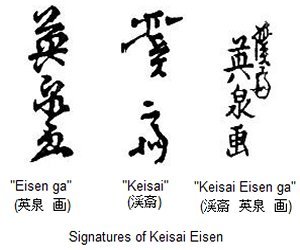| |
EISEN
|
|
Artist ¨C Keisai
Eisen (œl”È Ó¢Èª, 1790 ¨C 1848) Japanese ukiyo-e artist who
specialised in bijinga (pictures of beautiful women). His best
works, including his ¨kubi-e ("large head pictures"), are
considered to be masterpieces of the "decadent" Bunsei Era
(1818¨C1830). Along with Kunisada and
Kuniyoshi, Eisen is considered one of the leading artists of
ukiyo-e's "decadent" period.
At an early age, he was apprenticed to Kan¨ Hakkeisai, from whom he took the name "Keisai", and after the death of his father he studied under Kikugawa Eizan. His initial works reflected the influence of his mentor, but he soon developed his own style.
His works are known for a certain voluptuousness and ripe sensuality, his figures lacking much of the grace and elegance of earlier bijin prints, but emphasizing in their place worldliness and a less disguised or mediated sexuality. These impressions are all the more confirmed in his erotic prints, which have a heavy, musky scent quite unlike previous works in this field.
He produced a number of surimono (privately issued prints), erotic prints, and landscapes, including "The Sixty-nine Stations of the Kiso Kaid¨", which he started and which was completed by Hiroshige. However, his most famous works are the bijin-e (pictures of beautiful women) which portrayed the subjects as more worldly than those depicted by earlier artists, replacing their grace and elegance with a less studied sensuality. He produced many portraits and full-length studies depicting the fashions of the time.
Eisen also produced a number of humorous prints or giga (Ch¨j¨±-jinbutsu-giga (øBª•ÈËÎï‘ï», literally "Animal-person Caricatures"), commonly shortened to Ch¨j¨±-giga (øBª•‘ï», literally "Animal Caricatures"), the best of them emphasizing children.
In addition to producing a prolific number of prints, he was a writer, producing biographies of the Forty-seven Ronin ("Kana dehon Ch¨±shingura") and several books, including a continuation of the Ukiyo-e Ruiko (History of Prints of the Floating World), a book which documented the lives of the ukiyo-e artists. His supplement is known as "Notes of a Nameless Old Man." He describes himself as a dissolute hard-drinker and frequenter of Yoshiwara, the prostitute quarter. Eisen claims to have been the owner of a brothel in Nezu in the 1830s which had burned down.
Although frequently described as dissolute, even by himself, Eisen was in fact a highly literate man, writing under the name Ippitsuan. He prided himself, as an Edoite, on a devil-may-care floating world sensibility, focused on living for the sensory pleasures of the moment.
At an early age, he was apprenticed to Kan¨ Hakkeisai, from whom he took the name "Keisai", and after the death of his father he studied under Kikugawa Eizan. His initial works reflected the influence of his mentor, but he soon developed his own style.
His works are known for a certain voluptuousness and ripe sensuality, his figures lacking much of the grace and elegance of earlier bijin prints, but emphasizing in their place worldliness and a less disguised or mediated sexuality. These impressions are all the more confirmed in his erotic prints, which have a heavy, musky scent quite unlike previous works in this field.
He produced a number of surimono (privately issued prints), erotic prints, and landscapes, including "The Sixty-nine Stations of the Kiso Kaid¨", which he started and which was completed by Hiroshige. However, his most famous works are the bijin-e (pictures of beautiful women) which portrayed the subjects as more worldly than those depicted by earlier artists, replacing their grace and elegance with a less studied sensuality. He produced many portraits and full-length studies depicting the fashions of the time.
Eisen also produced a number of humorous prints or giga (Ch¨j¨±-jinbutsu-giga (øBª•ÈËÎï‘ï», literally "Animal-person Caricatures"), commonly shortened to Ch¨j¨±-giga (øBª•‘ï», literally "Animal Caricatures"), the best of them emphasizing children.
In addition to producing a prolific number of prints, he was a writer, producing biographies of the Forty-seven Ronin ("Kana dehon Ch¨±shingura") and several books, including a continuation of the Ukiyo-e Ruiko (History of Prints of the Floating World), a book which documented the lives of the ukiyo-e artists. His supplement is known as "Notes of a Nameless Old Man." He describes himself as a dissolute hard-drinker and frequenter of Yoshiwara, the prostitute quarter. Eisen claims to have been the owner of a brothel in Nezu in the 1830s which had burned down.
Although frequently described as dissolute, even by himself, Eisen was in fact a highly literate man, writing under the name Ippitsuan. He prided himself, as an Edoite, on a devil-may-care floating world sensibility, focused on living for the sensory pleasures of the moment.
Personal
life - Eisen was born in Edo
into the Ikeda family as
IKEDA Zenjiro, the son of a noted calligrapher. He
apparently taught the young Zenjiro (Eisen's childhood
name) the way of the brush.
Aliases - His names and aliases include IKEDA Zenjiro, IKEDA Eisen, Eisen, Keisai Eisen, and Ippitsuan
Aliases - His names and aliases include IKEDA Zenjiro, IKEDA Eisen, Eisen, Keisai Eisen, and Ippitsuan
Disciples - no known disciples
Copyright 2008 ff: Hans P. Boehme
